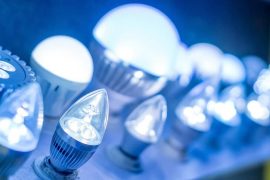Talking about luminescence, an LED bulb will give you the same amount compared to an incandescent bulb (typically).

But when it comes to power consumption, here is the surprise.
Because a typical LED bulb will consume very less power comparatively.
Due to this very reason, the demand for LED bulb has been increasing day by day.
If you are in favor of saving energy, then you should switch to LED bulbs.
LEDs For A 15 Amp Circuit
If an incandescent bulb consumes 60 watts, in comparison, an LED bulb will consume even less than 10 watts.
Hence, if your circuit has a certain fixed amount of source value of current, then you can use a lot more LED bulbs than incandescent bulbs.
Mathematically
As we see, a typical LED bulb consumes less than 10 watts of power. It is almost equal to 1/12 amp of current. Hence,
12 bulbs = 1 amp
180 bulbs = 15 amp
So, we see that according to a rough analysis, a 15 amp circuit can safely support as much as 180 LED bulbs, and this count can go further beyond with some further analysis.
Household Circuits
If we talk about a standard for household circuits, we see that most of them are rated 15 amp or 20 amp.
But when we think about circuit breakers, they can handle only 80% of their total amperage.
Thus, we can see that a 15 amp circuit breaker can handle only 12 amp of current while 20 amp can handle only 16 amp of current.
Hence if we come on reducing the available circuit current, then statistically, we can safely use 140+ LED bulbs on the circuit of 15 amp if the circuit breaker handles 80% of the whole amperage.
A 15 amp circuit mathematically can provide 180 fixtures in the case of LED bulbs, and we can see that if the available amperage is even lesser, we still have 140+ fixtures’ space for the LEDs that can be used in them.
Comparison
A question arises that how can we place around 180 LED bulbs in a circuit where only about 30 traditional bulbs of that much luminescence can be accommodated.
So here is a little comparison;
Talking about efficiency? LED lights are up to 80% more efficient than the other bulbs like fluorescent and incandescent bulbs.
Talking about energy waste? 95% of the total energy is converted into light, while only 5% is wasted into heat energy.
Also, in the case of LEDs, greenhouse gas emission is decreased because demand from power plants is reduced.
Conclusion
After going through a fair enough analysis, we see that LED bulbs are not only the least consuming so far, but also they are very efficient and environmental-friendly.
If you have a circuit of 15 amp rating, which is normally used in households, you can use many of the LED bulbs in that with comparatively a very low consumption of energy.





